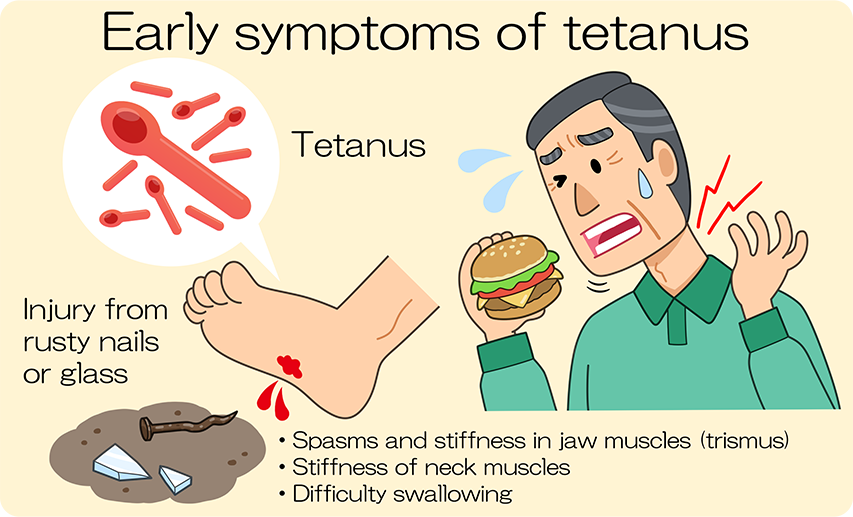Tetanus is an infectious disease caused by Clostridium tetani, a biologically anaerobic Gram-positive bacillus that was successfully cultured by Shibasaburo Kitasato, which produces an exotoxin that causes neurological symptoms and may be fatal. Tetanus bacillus is endemic in soil in the form of spores and invades the body through the site of a wound, but it is important to note that the disease can occur without an obvious wound.
The incubation period is considered to be about 8 days (3-21 days), but about 80% of cases are of the generalized type, in which muscle rigidity begins with a disturbance of mouth opening and spreads from the neck to the whole body. The shorter the time between the disturbance of mouth opening and the appearance of generalized symptoms (spasm, posterior arch retraction), the more severe the disease.
One method of prevention is vaccination with tetanus toxoid. In Japan, vaccination began in 1968 under the Immunization Law.1),2) A survey of tetanus antibody titers conducted in 2008 revealed that only about 10% of persons aged 45 years or older maintained tetanus antibody titers at the prophylactic range level.3) In Japan, tetanus toxoid vaccination has been used as a preventive method since 1968. In light of these findings, tetanus human immunoglobulin should be aggressively considered for those over 50 years of age who were born before vaccination if they are considered to be at high risk for tetanus infection.
Tetanus is characterized by the fact that it does not develop and can be prevented when antibody titers are sufficiently elevated at 0.01 IU/ml or higher, but the positive rate is extremely low at less than 30% for those over 40 years of age 4).
Tetanus is defined as a category 5 infectious disease under the Infectious Disease Control Law, and physicians who diagnose the disease are required to report it to the public health department and investigate outbreaks of the disease.
In normal times, appropriate wound care and prophylactic immunotherapy are the main tetanus countermeasures during initial trauma care. The number of patients with tetanus is expected to increase because it is difficult to provide the same wound care, including wound cleaning and tetanus toxoid administration, as in normal times due to the extreme shortage of medical resources in times of disaster. However, during the December 26, 2004 Sumatra earthquake and tsunami disaster, the number of tetanus cases in Banda Aceh, Indonesia, was reported to be 106, with a mortality rate of 18.9%).
1) Okada K, Ueda K, Morokuma K, et al. Seroepidemiologic study on pertussis, diphtheria, and tetanus in the Fukuoka area of southern Japan: seroprevalence among persons 0-80 years old and vaccination program. Jpn J Infect Dis 2004;57:67-71.
2) Takahashi M, Komiya T, Fukuda T, et al. A comparison of young and aged populations for the diphtheria and tetanus antitoxin titers in Japan. Jpn J Med Sci Biol 1997;50:87-95.
3) Tetanus in Japan as of Deember 2008. IASR 2009;30:65-6. [cited 2017 Feb 18] Available from: http://idsc.nih.go.jp/iasr/30/349/inx349-j.html
4) Takahashi M. Tetanus. Pathogenic Microorganism Detection Information 2009;30:65-6.
5) Aceh Epidemiology Group. Outbreak of tetanus cases following the tsunami in Aceh Province, Indonesia. Glob Public Health 2006;1:173-7.
